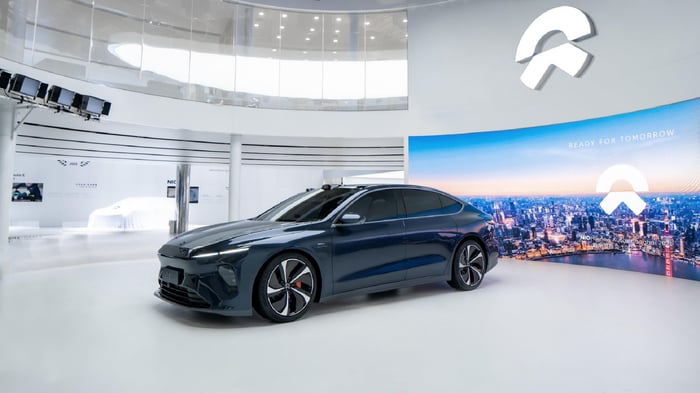Two Wall Street analysts expect two leading artificial intelligence (AI) stocks to surge 102% and 116% over the next 12 months.
When the Internet began to become a mainstream communication tool thirty years ago, it completely changed the growth trajectory of American and global businesses. After decades of patient waiting, Wall Street and investors have identified what they see as the next game-changing innovation that will change the growth trajectory of American businesses: artificial intelligence (AI).
AI relies on software and systems to handle tasks that would normally be handled by humans. What makes this technology so appealing is the ability of AI software and systems to learn and evolve over time without human intervention or oversight. This makes AI useful in virtually every sector and industry.

Image source: Getty Images.
Wall Street and its analysts are well aware that the long-term potential of artificial intelligence is there to be exploited. Most of the price targets set by Wall Street pundits and financial institutions point to an increase in the leading AI stocks. But that doesn’t mean the outlook for all AI stocks is equal.
While most experts expect the hardware pivot of AI, Nvidia (NVDA -5.57%)to increase in value over the coming year, lofty price targets from some Wall Street analysts suggest two other AI stocks could more than double investors’ money over the next 12 months and leave Nvidia in the dust.
Wall Street’s leading artificial intelligence stock could be in for a bumpy ride
Of the more than three dozen analysts and experts who have weighed in on Nvidia, none is more optimistic about its future than Rosenblatt’s Hans Mosesmann.
Following Nvidia’s historic stock split in early June, Mosesmann raised his and his firm’s price target on the company from $140 to $200 per share. That implies a valuation of nearly $5 trillion and would send the stock up 59% from its July 5 closing price.
Mosesmann’s lofty price target is based on Nvidia maintaining its dominance in two key aspects of the AI revolution. The first is its near-monopolistic market share of AI-powered graphics processing units (GPUs). TechInsights analysts found that Nvidia was responsible for 3.76 million of the 3.85 million AI GPUs shipped in 2023. With clear computing advantages and a backlog of next-gen GPU architectures (Blackwell and Rubin) in the pipeline, Mosesmann predicts that Nvidia will be the go-to hardware vendor for AI-accelerated data centers.
Mosesmann also expects Nvidia to reap the benefits of its CUDA platform, which is the toolkit that developers use to create large language models. That software fits neatly into Nvidia’s hardware monopoly of keeping AI-focused companies locked into its ecosystem of products and services.
Despite the overwhelming euphoria around Nvidia, the road ahead for the company is likely to be significantly bumpier than the previous 18 months.
For example, competition is intensifying at a rapid pace. In addition to battling external AI GPU developers, Nvidia’s top four customers by net sales are developing AI chips for their data centers. Even if Nvidia’s chips maintain their compute advantage, the mere presence of additional AI GPUs will minimize the shortage that has sent Nvidia’s GPU prices soaring and weigh on its margins.
Moreover, history doesn’t square with most Wall Street analysts. Including the advent of the internet, every major innovation, technology, and trend of the last three decades has emerged within a bubble. Given that no company has benefited more directly from the rise of AI than Nvidia, it would likely be the most likely to be hit hard if the AI bubble bursts.
While Nvidia’s path may be bumpy, two Wall Street analysts believe two other AI stocks could revolve around the artificial intelligence leader over the next year.

Image source: Nio.
Nio: Implied upside potential of 116%
The first AI stock that could leave Nvidia in the dust, at least in terms of performance over the next year, is the Chinese electric vehicle (EV) maker. Nio (NIO 1.30%). According to Morgan Stanley Nio could hit $10 per share, which would represent a 116% increase from its July 5 closing price, according to analyst Tim Hsiao.
One factor fueling Hsiao’s optimism is Nio’s rapid growth in production and shipments. In particular, Nio has been averaging about 5,000 orders per week, or about 20,000 shipments per month. Overcoming the worst of the COVID-19 pandemic, which led to strict lockdowns in China, has helped unwind supply chain issues that had previously held back Nio’s production expansion.
To complement this point, Nio has completed the transition of its fleet to its new NT 2.0 platform. This new platform incorporates a number of advanced driver assistance system upgrades, including autonomous driving capabilities, which is one aspect of Nio’s ties to AI. Since the transition to NT 2.0, demand for Nio’s electric vehicles has increased.
Hsiao and his team are also excited about the 2024 launch of Nio’s second vehicle brand, known as Onvo. While Nio has primarily focused on high-income consumers with its existing lineup, Onvo is a family-oriented battery electric vehicle brand with a lower price point that can be a more direct competitor to brands like You’re here in China.
The final piece of the puzzle is that the company is swimming in capital. The company ended the March quarter with about $6.3 billion in cash, cash equivalents, and various investments. That gives Nio ample room to introduce new electric vehicles and ramp up production.
The problem with all of the above is that building a car company from scratch is no easy task. Nio is still burning cash and isn’t particularly close to turning a profit. While Onvo and its battery-as-a-service subscription might be able to boost margins, Nio remains a work in progress that will require patience from its shareholders.
Baidu: 102% increase
The second AI stock that’s expected to more than double investors’ money and leave Nvidia eating dust is another China-based company, Baidu (TO START 2.79%)Baidu is on track to hit $180 a share — a 102% gain from its July 5 closing price — within the next 12 months, according to Benchmark analyst Fawne Jiang.
Baidu is best known for its market-leading Internet search engine. The company’s search engine accounted for about 53% of Internet searches in the world’s second-largest economy by gross domestic product in June, according to data from GlobalStats. With a few exceptions, Baidu has controlled a monthly share of 50% to 85% of Internet searches in China for the past decade.
As China’s leading internet search engine, Baidu is often able to impose considerable advertising pricing power on companies. Although China’s economic recovery from the COVID-19 pandemic has been fraught with more challenges than initially anticipated, it’s hard to imagine Baidu struggling for long while maintaining a clear advertising advantage.
However, it is Baidu’s ancillary AI business that could be its main growth driver for the rest of the decade (and possibly beyond). Baidu’s AI Cloud is the fourth-largest cloud infrastructure services platform in China, by total spending. Enterprise spending on cloud services is in its infancy, and cloud service margins are much more attractive to Baidu than advertising margins.
In addition, Baidu is the parent company of Apollo Go, the world’s first autonomous transportation service. As of April 19, Apollo Go has exceeded 6 million cumulative rides since its inception.
Like Nio, Baidu also has a treasure trove of available capital. The company ended the first quarter with about $26 billion in cash, cash equivalents, and various investments at its disposal. Given Baidu’s forward price-to-earnings ratio of just 7.5, the company’s risk/reward profile would certainly favor an upside.